For all the uniqueness of this NFL draft, including the angst over a potential communications fiasco, things looked and sounded pretty normal Thursday night.
Quarterbacks were in demand. Ohio State and the Southeastern Conference dominated. The Patriots traded out of the first round.
And Commissioner Roger Goodell even got booed, if only digitally.
“I do believe this draft is going to be the most memorable we have ever had,” said Goodell, noting that it is accompanied by a “Draft-A-Thon” to benefit six organizations on the front lines battling the coronavirus pandemic, which is what forced the NFL to cancel all in-person draft events.
The first round wasn’t all that remarkable for the picks. Beginning with Joe Burrow of national champion LSU, three quarterbacks went in the top six. Hardly unusual.
For months, the Heisman Trophy winner from LSU was linked with the Bengals. Cincinnati began the draft by sending his name to Goodell in the basement of his home.
This digital/remote/virtual draft — take your choice — was up and running. With no apparent glitches.
Of course, there were no fireworks on the Las Vegas Strip. No bear hug between Goodell and Burrow; the commissioner said he would miss those, even if his body wouldn’t. This most basic selection show had team personnel making picks from their homes and players sitting on their own couches while learning their future employers.
The NFL canceled all draft activities in Las Vegas when the national shutdown of large gatherings began. The league had gone full-bore into free agency last month and, now, seven rounds of the draft through Saturday.
“I just believe that our job is to continue on and operate within whatever guidelines are necessary to keep our personnel safe, whether it’s players or coaches or their executives or league personnel,” Goodell said. “We need to make sure that we’re doing things safely and put public safety No. 1, but we also need to carry on. We need to move toward the future. We need to make sure that we’re prepared when we come out of this to be in a position to start our season on time and play our season. That’s our role.”
Normalcy, at least among the picks, was the order of the evening, though.
First came Burrow: In his spectacular senior season, he threw for 60 — yes, 60 — touchdowns with only six interceptions. The Tigers beat six top 10 teams on their way to the national title.
“To jump up to No. 1 overall is crazy to me,” Burrow said.
He joins a team that went 2-14 last season and desperately needs a jolt of energy.
“If you go in thinking, ‘Oh, this is the year we’re going to make the playoffs, this year we’re going to win a playoff game,’ it gets too daunting,” Burrow said. “You’ve got to focus on the process.”
Bengals coach Zac Taylor was confident Burrow could turn the franchise around.
“We will never pick at No. 1 again,” Taylor said. “We don’t want to pick in the top 10 again. We’re looking at this as the only time you’re going to get this caliber player to add him to the program, so obviously this is a big deal.”
The second overall selection, Ohio State All-America edge rusher Chase Young, also was predictable. Washington fielded several offers for that spot, but many scouts and personnel executives felt Young was the best player in this crop.
At 6-foot-5, 264 pounds, Young led the nation with 16 1/2 sacks and forced fumbles with six last season. The All-American won the prestigious Bednarik and Nagurski awards in 2019, leading the Buckeyes to the Big Ten title.
He joins a Redskins team that went 3-13 and allowed 435 points.
If not for the NFL’s obsession with finding the latest, greatest quarterback prospect, Young might have been the top overall selection. That QB infatuation led Miami to Tua Tagovailoa and the Los Angeles Chargers to Justin Herbert — no surprises there. But Green Bay took a chance at No. 26 by taking Utah State QB Jordan Love.
Alabama’s Tagovailoa went fifth, followed in the next spot by Oregon’s Herbert. They were preceded by Ohio State’s Jeff Okudah, the highest-rated cornerback, to Detroit, and Georgia tackle Andrew Thomas to the Giants.
Tagovailoa’s health issues didn’t turn off the Dolphins.
The Alabama quarterback went to a team that was accused going into last season of “Tanking for Tua.” Tagovailoa comes off major hip surgery, which made his landing spot one of the first round’s biggest uncertainties.
“For me and my family, whoever decided to take a chance on us, that’s where I belonged,” Tagovailoa said. “My biggest thing is I’m trying to prove this was the right decision.”
One change he’ll need to make in Miami: No. 13 is not available. The Dolphins retired it for Hall of Famer Dan Marino.
“I understand No. 13 is retired, and it should be,” Tagovailoa said. “Whatever number I’m given by the organization, if it’s 78 or 99, I’ll wear it.”
Blessed with a quick release, excellent mid-range accuracy and nimble feet, Tagovailoa threw 76 touchdown passes in 24 starts the past two seasons. He helped the Crimson Tide to the 2017 national title.
Herbert had a strong postseason, including a terrific Senior Bowl week that raised his stock. At 6-foot-6, 236 pounds, he has the size the pros like, and he’s a good athlete. But he also is not as accurate passing as he’ll need to be.
Los Angeles had a burning hole at quarterback after letting go of longtime starter Philip Rivers. Plus, the Chargers plan to move into a new stadium and could use someone to help sell tickets.
It took until the 13th spot before a trade was made: Tompa, oops, Tampa Bay moving up one spot to get tackle Tristan Wirfs of Iowa to help protect new/old QB Tom Brady. The Buccaneers got that pick from NFC champion San Francisco.
Wide receiver is the deepest position in this draft, but it took until the 12th selection for one to go. Alabama’s Henry Ruggs III, perhaps the fastest man in this group (4.27 in the 40), was the first-ever draftee by the Las Vegas Raiders. Coach Jon Gruden loves speed, and he got a burner who scored 24 touchdowns among 98 career receptions.
New England, which will go into a season without Brady for the first time since 1999, sent its 23rd overall spot to the Chargers, adding a second- and third-rounder. The Chargers were eager to bolster their defense with Oklahoma linebacker Kenneth Murray.
The Packers, despite needs at receiver, offensive line and linebacker, traded up from No. 30 to 26th and selected for the future with Love. Aaron Rodgers, of course, sat for a few years in Green Bay behind Brett Favre. Love might do the same behind A-Rod.
Here’s a blow-by-blow breakdown of the first round picks:
Round 1, Pick 32: Kansas City – Clyde Edwards-Helaire, 5-7, 207, LSU;
- Strengths: Shifty with great balance.
- Weaknesses: So-so speed, especially for his size.
- Fact: Had 55 receptions for 453 yards last season.
TRADE: Round 1, Pick 31: Minnesota – Jeff Gladney, 5-10, 191, TCU (from San Francisco)
- Strengths: Quick and fierce.
- Weaknesses: Size could limit him to slot.
- Fact: Led the Big 12 with 14 passes broken up in 12 games.
Round 1, Pick 30: Miami – Noah Igbinoghene, 5-10, 198, Auburn
From Auburn Athletics: Returning starter at cornerback with 42 tackles, 7 PBU for season. He was a preseason all-SEC 2nd team (Phil Steele), 3rd team (Athlon); Paul Hornung Award watch list.
Round 1, Pick 29: Tennessee –Isaiah Wilson, 6-6, 350, Georgia
- Strengths: Ideal size and build.
- Weaknesses: Fundamentals and technique have a ways to go.
- Fact: Two-year starter at right tackle who redshirted as a freshman.
Round 1, Pick 28: Baltimore – Patrick Queen, 6-0, 229, LSU
- Strengths: Speed and athleticism make him valuable in coverage or blitzing.
- Weaknesses: Size makes him more of a chaser against the run.
- Fact: Defensive player of the game in the national championship against Clemson.
Baltimore — which had the NFL’s best record in the regular season — took LSU linebacker Patrick Queen with the 28th pick.
Round 1, Pick 27: Seattle – Jordyn Brooks, 6-0, 240, Texas Tech
From TexasTech.com: Closed his Red Raider career as one of the top linebackers in the country putting together one of the best seasons by a Red Raider in school history. He’s one of 16 players and one of five seniors named to the captains circle leading up to the season. He was limited due to injury during the last part of his senior season.
TRADE: Round 1, Pick 26: Green Bay – Jordan Love, 6-4, 224, Utah State (from Miami)
- Strengths: Big and talented arm. Tall, smooth athlete.
- Weaknesses: Telegraphs some throws and will bail out of workable pockets at times.
- Fact: TD-to-INT ratio went from 32:6 in 2018 to 20:17 last season.
Green Bay has a likely Hall of Fame quarterback, Aaron Rodgers. The Packers now have perhaps his successor, Utah State’s Jordan Love.
After trading up with Miami to go from 30th to 26th, the Packers pulled off probably the most stunning move of the first round.
Love is a developmental project compared to the other three quarterbacks taken earlier — LSU’s Joe Burrow, Alabama’s Tua Tagovailoa and Oregon’s Justin Herbert. And remember that Rodgers, now 36, sat behind Brett Favre early in his career.
TRADE: Round 1, Pick 25: San Francisco – Brandon Aiyuk, 6-0, 205, Arizona State (from Minnesota)
- Strengths: Dangerous after the catch.
- Weaknesses: Needs to play stronger in traffic.
- Fact: Missed the Senior Bowl after abdominal injury.
San Francisco made a deal and moved up six positions by trading with Minnesota, and at No. 25 added a receiver to a group that lost veteran Emmanuel Sanders in free agency. Arizona State’s Brandon Aiyuk was the pick, while the Vikings moved down to 31st overall.
Round 1, Pick 24: New Orleans – Cesar Ruiz, 6-2, 307, Michigan
- Strengths: Solid build. Plays smart and instinctive.
- Weaknesses: Quickness is lacking.
- Fact: Started the final 31 games of his career.
The New Orleans Saints fortified the interior of their offensive line, taking Michigan center Cesar Ruiz.
TRADE: Round 1, Pick 23: LA Chargers – Kenneth Murray, 6-2, 241, Oklahoma (from New England)
- Strengths: Sideline-to-sideline playmaker.
- Weaknesses: Can fly out of position and into bad angles.
- Fact: Had 17 tackles for loss and four sacks and four pass breakups in 14 starts.
The Chargers traded up, taking the 23rd pick from New England and selecting Oklahoma linebacker Kenneth Murray, who had 17 tackles for loss, including four sacks last season.
Round 1, Pick 22: Minnesota – Justin Jefferson, 6-1, 202, LSU
- Strengths: Dominated from the slot with great body control.
- Weaknesses: Size and strength weren’t tested much in LSU’s offense.
- Fact: Led major college football with 111 catches last year for 1,540 yards.
The Minnesota Vikings filled the hole left by the trade of Stefon Diggs to Buffalo for this pick by selecting LSU’s Justin Jefferson, who had 111 catches last season for the national champions.
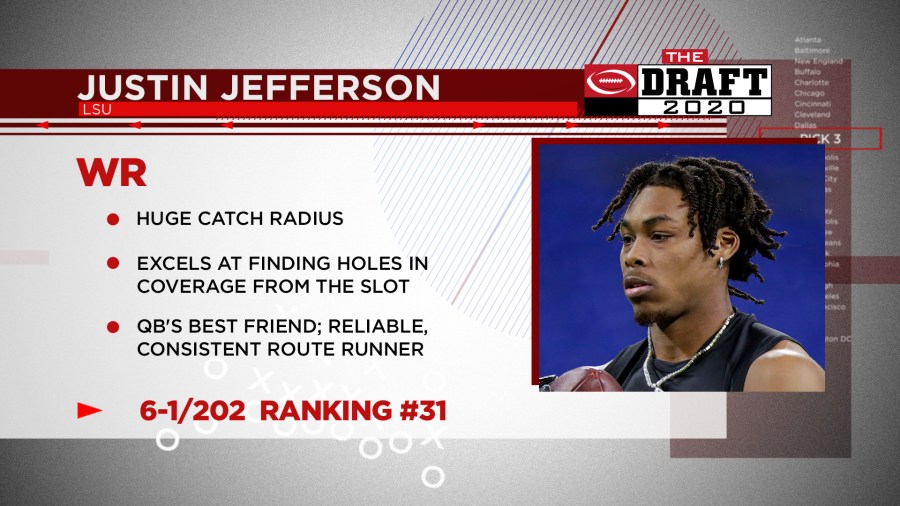
Round 1, Pick 21: Philadelphia – Jalen Reagor, 5-11, 194, TCU
- Strengths: Speed to get deep and shiftiness to turn short plays into long gains.
- Weaknesses: Can get pushed around in coverage.
- Fact: The son of former Texas Tech star and longtime NFL defensive lineman Montae Reagor.
Philadelphia started a little run on wide receivers.
The Eagles filled their need for a receiver by taking Jalen Reagor from TCU with the 21st overall pick. Reagor, whose father Montae was a defensive lineman in the NFL who won a Super Bowl with the Colts, is a speedster and skilled punt returner.
He had a 1,000-yard season as a sophomore in 2018, but his production fell off in 2019 because of injuries and inconsistent quarterback play.
Round 1, Pick 20: Jacksonville – K’Lavon Chaisson, 6-3, 254, LSU
- Strengths: Explosive and agile with speed to run down plays.
- Weaknesses: Injuries cost him most of 2018 and some of 2019 and left him with an unrefined game.
- Fact: Led the national champions in tackles for loss (13 1-2) last season.
Jacksonville’s second pick was K’lavon Chaisson, a dynamic linebacker from national champion LSU. He led the Tigers in tackles for loss (13 1-2) last season, but has an injury history.
Round 1, Pick 19: Las Vegas – Damon Arnette, 6-0, 195, Ohio State
Arnette was projected to be a pick in the second round. According to NFL.com, he considered leaving for the NFL after his junior season but after conversations with his coaches and former Buckeye and NFL receiver Cris Carter, decided to hang tight in Columbus for one more year. Arnette finished his career with a second-team All-Big Ten performance (35 tackles, one for loss, one interception, eight pass breakups in 13 starts) for the College Football Playoff participants, per NFL.com.
The Raiders, moments after being told by Commissioner Roger Goodell that the 2022 draft will be staged in Las Vegas, might have gone gambling at No. 19. They took Damon Arnette, the No. 2 cornerback at Ohio State behind third overall selection Jeff Okudah.
Round 1, Pick 18: Miami – Austin Jackson, 6-4, 322, USC
- Strengths: Long arms and light on his feet.
- Weaknesses: High upside, but very raw.
- Fact: Turns 21 in August, making him one of the youngest players available in the draft.
Miami added some protection up front for Tagovailoa with Southern California tackle Austin Jackson. At 6-foot-4, 322, he has long arms and is light on his feet. He’s also only 20 years old, one of the youngest players available in the draft.
Round 1, Pick 17: Dallas – CeeDee Lamb, 6-1, 195, Oklahoma
- Strengths: Game-breaking elusiveness after the catch.
- Weaknesses: Will have to develop quickness off the line to beat press coverage.
- Fact: All-American and Biletnikoff Award finalist last season.
Dallas bolstered an already strong receiving unit that includes Amari Cooper and Michael Gallup by taking Oklahoma playmaker CeeDee Lamb, another All-American. Lamb was a Biletnikoff Award finalist last season.
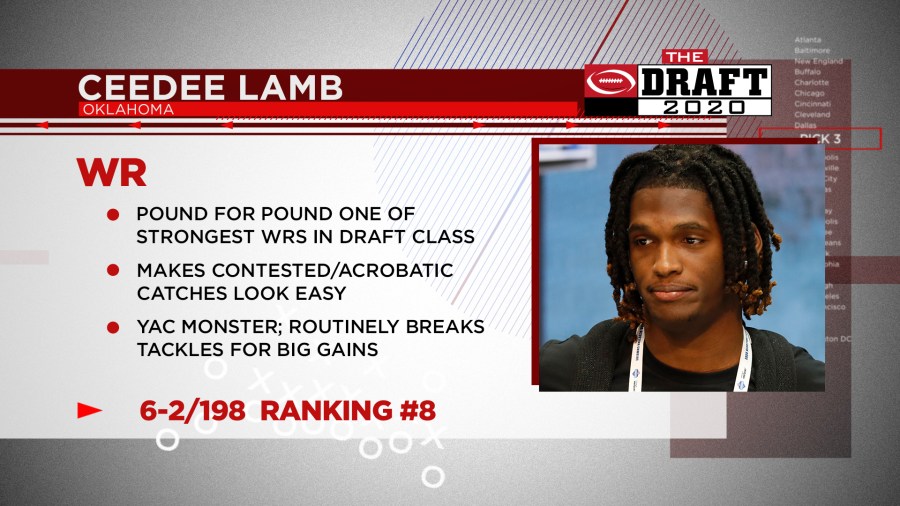
Round 1, Pick 16: Atlanta – A.J. Terrell, 6-1, 195, Clemson
- Strengths: Tall and steady with excellent speed.
- Weaknesses: Lean lower body. Could be more aggressive.
- Fact: Had a pick-6 in the 2018 College Football Playoff championship against Alabama and then got picked on by LSU in last year’s title game.
Atlanta, desperate to upgrade the defense, took matters to the halfway point by grabbing cornerback A.J. Terrell of Clemson.
Round 1, Pick 15: Denver – Jerry Jeudy, 6-1, 193, Alabama
- Strengths: Smooth and polished route runner with excellent burst.
- Weaknesses: Slim build lacks strength.
- Fact: Caught 26 touchdown passes, second behind only Amari Cooper in Alabama history.
A second Crimson Tide receiver, Jerry Jeudy, was taken by Denver, at No. 15, perhaps hoping to emulate the fast-paced Super Bowl champion Chiefs who dominate the AFC West.
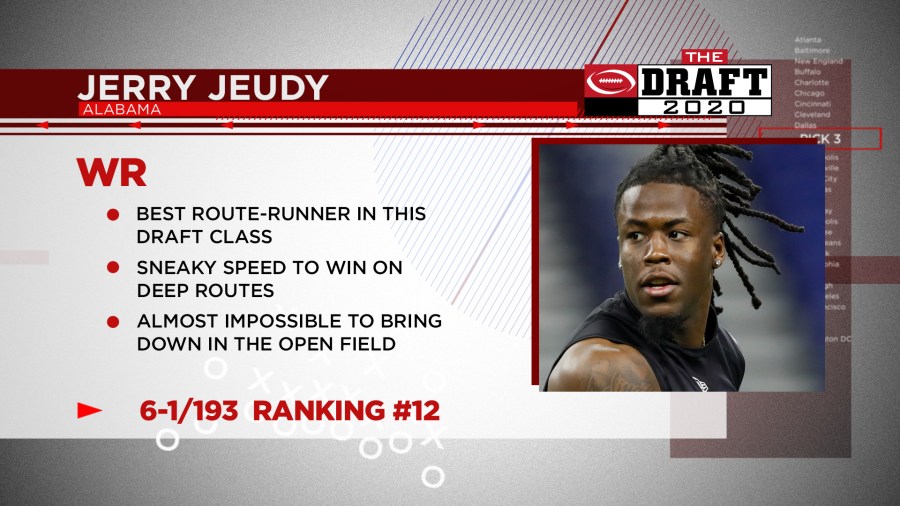
TRADE: Round 1, Pick 14: San Francisco – Javon Kinlaw, 6-5, 324, South Carolina (from Tampa Bay)
- Strengths: Long, athletic and powerful as a pass rusher.
- Weaknesses: More tools than consistent technique.
- Fact: First-team All-American
San Francisco selected Javon Kinlaw of South Carolina. That made five defensive linemen in the first round of the past six drafts for the 49ers, who last month traded DT DeForest Buckner to Indianapolis for the pick they dealt to the Bucs.
TRADE: Round 1, Pick 13: Tampa Bay – Tristan Wirfs, 6-5, 320, Iowa (from San Francisco)
- Strengths: Rare athleticism for his size.
- Weaknesses: Arm length is less than ideal.
- Fact: Ran a 4.85-second 40-yard dash at the combine.
It took until the 13th spot before a trade was made, Tampa Bay moving up one slot to get tackle Tristan Wirfs of Iowa to help protect new/old QB Tom Brady.
The Buccaneers got that pick from NFC champion San Francisco, which went next and selected Javon Kinlaw of South Carolina. That made five defensive linemen in the first round of the past six drafts for the 49ers, who last month traded DT DeForest Buckner to Indianapolis for the pick they dealt to the Bucs.
San Francisco got the 117th overall selection and sent a seventh-rounder (No. 245) to Tampa.
A second Crimson Tide receiver, Jerry Jeudy, was taken by Denver, at No. 15, perhaps hoping to emulate the fast-paced Super Bowl champion Chiefs who dominate the AFC West.
Atlanta, desperate to upgrade the defense, took matters to the halfway point by grabbing cornerback A.J. Terrell of Clemson.
Round 1, Pick 12: Las Vegas – Henry Ruggs III, 5-11, 188, Alabama
- Strengths: Elite speed and acceleration.
- Weaknesses: His game is somewhat limited but what he does well is hard to find.
- Fact: Almost 25% of his 98 career receptions went for touchdowns (24).
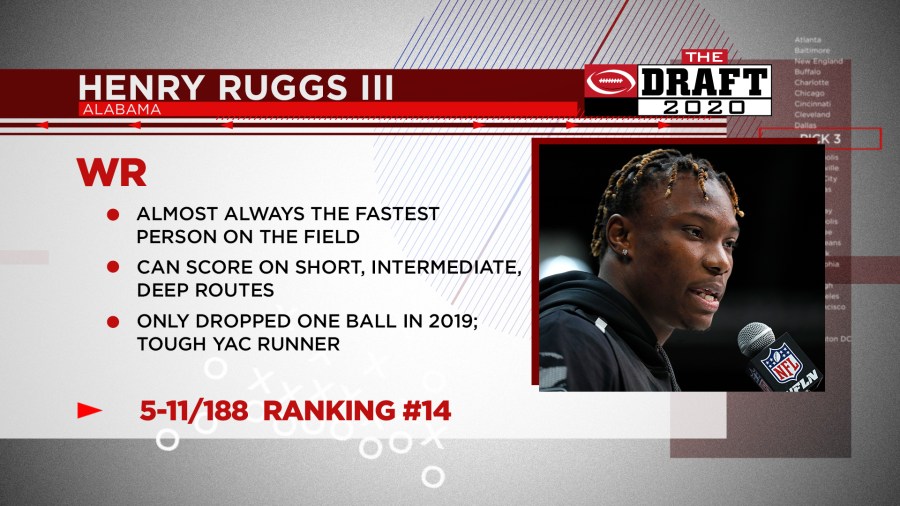
Round 1, Pick 11: NY Jets – Mekhi Becton, 6-7, 365, Louisville
- Strengths: Huge and nimble for his size.
- Weaknesses: Technique needs to be refined.
- Fact: Has 7-foot wingspan.
Sam Darnold has a protector.
Louisville’s massive but quick Mekhi Becton, who at 6-foot-7, 365 pounds ran a 5.1-second 40 at the scouting combine, is headed to the Jets.
General manager Joe Douglas promised he would find a target and a blocker for his third-year quarterback. Becton, who went 11th overall, has a 7-foot wingspan.
The first pick in the history of the Las Vegas Raiders was next and made plenty of sense. Coach Jon Gruden loves speed, and in Henry Ruggs III of Alabama, he has a burner who finds the end zone.
Get this: Ruggs, who has run a 4.27 40, has 24 touchdown receptions in 98 career catches.
Round 1, Pick 10: Cleveland – Jedrick Wills, 6-4, 312, Alabama
- Strengths: Plays smart and mean.
- Weaknesses: Lacks ideal size.
- Fact: Allowed one sack in 39 college games, playing exclusively at right tackle.
After signing right tackle Jack Conklin as a free agent, the Cleveland Browns added a bookend in the draft with Alabama’s Jedrick Wills.
Quarterback Baker Mayfield must be smiling at those moves.
How good a pass protector is Wills? He allowed one sack in 39 college games, playing exclusively at right tackle. Of course, the Crimson Tide had a left-handed QB, Tua Tagovailoa, so Wills was protecting the blind side.
Look for him to move to the left side and do the same for Mayfield.
Round 1, Pick 9: Jacksonville – CJ Henderson, 6-1, 204, Florida
- Strengths: Burst to make up ground.
- Weaknesses: Locating and playing the ball can be spotty.
- Fact: Ankle injury limited him to nine games last season, but still had 11 passes broken up.
C.J. Henderson doesn’t have to go very far for his pro football job.
The Florida cornerback was selected ninth overall by Jacksonville. The Jaguars are seeking a solid coverage guy after trading Jalen Ramsey to the Rams last year.
Henderson has good size at 6-foot-1, 204 pounds, and is very quick. He covered the top wideouts the Gators played and usually dominated when healthy — an ankle injury limited him to nine games last season, but he still had 11 passes broken up.
Round 1, Pick 8: Arizona – Isaiah Simmons, 6-4, 238, Clemson
- Strengths: Maybe the best athlete in the draft. The perfect modern defender, capable of playing three or four positions.
- Weaknesses: Ummmmm?
- Fact: ACC defensive player of the year and a finalist for three national defensive player of the year awards (Bednarik, Nargurski, Lott IMPACT)
The Arizona Cardinals picked Clemson linebacker Isaiah Simmons with the eighth overall pick, grabbing maybe the most versatile defensive player available.
Simmons was the Butkus Award winner as the nation’s top linebacker last year, but he was used in numerous positions for the Tigers. He lined up at safety, slot corner and edge rusher at times. He has defensive back speed at 6-foot-4, 238 pounds.
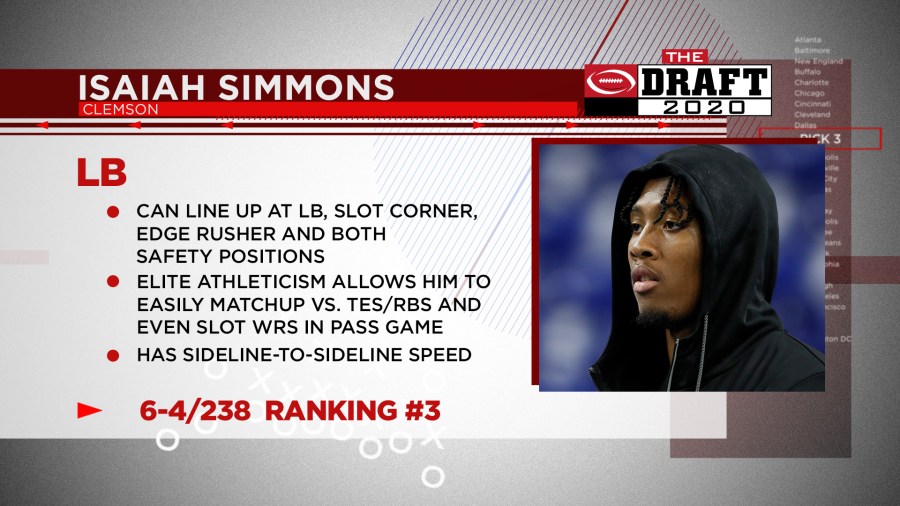
Round 1, Pick 7: Carolina – Derrick Brown, 6-5, 326, Auburn
- Strengths: Elite size and strength that demands double teams — which he can beat.
- Weaknesses: Agility could limit him as a pass rusher.
- Fact: Finalist for the Chuck Bednarik Award (top defensive player) and Outland Trophy (best lineman).
The Carolina Panthers selected Auburn defensive tackle Derrick Brown with the seventh overall selection.
Brown returned for his senior year and was a finalist for the Chuck Bednarik Award (top defensive player) and Outland Trophy (best lineman) last season and considered the clear top interior defensive lineman available.
The selection is the first for a new regime with Carolina as coach Matt Rhule looks to rebuild. The 6-foot-5, 326-pound Brown could be the anchor of the defense going forward.
Round 1, Pick 6: LA Chargers – Justin Herbert, 6-6, 236, Oregon
- Strengths: Ideal size and a good athlete.
- Weaknesses: Spotty touch. His passes often sail when he lets loose.
- Fact: Surprisingly returned for his senior year to his hometown school and increased his completion percentage from 59.4 percent to 66.8.
Oregon’s Justin Herbert became the third quarterback selected in this year’s NFL draft, going sixth overall to the Los Angeles Chargers.
Herbert had a strong postseason, including a terrific Senior Bowl week that raised his stock. At 6-foot-6, 236 pounds, he has the size the pros like, and he’s a good athlete. But he also is not as accurate passing as he’ll need to be.
Los Angeles had a burning hole at quarterback after letting go of long-time starter Philip Rivers. Plus, the Chargers plan to move into a new stadium and could use someone to help sell tickets.
A former sixth-stringer for the Ducks, he comes from a football-playing family going back to his grandfathers.
Round 1, Pick 5: Miami – Tua Tagovailoa, 6-0, 217, Alabama
- Strengths: Quick release, with excellent mid-range accuracy and nimble feet.
- Weaknesses: Coming off a serious hip injury.
- Fact: Threw 76 touchdown passes in 24 starts the past two seasons.
Tua Tagovailoa’s health issues didn’t turn off the Miami Dolphins.
The Alabama quarterback, whose resume is as strong as any player in this draft were it not for several injuries in his college career, went fifth overall to a team that was accused going into last season of “Tanking for Tua.” Tagovailoa comes off major hip surgery, which made his landing spot one of the first round’s biggest uncertainties. A completely healthy Tagovailoa might have been the top overall pick.
Blessed with a quick release, excellent mid-range accuracy and nimble feet, Tagovailoa threw 76 touchdown passes in 24 starts the past two seasons. He helped the Crimson Tide to the 2017 national title.

Round 1, Pick 4: NY Giants – Andrew Thomas, 6-5, 315, Georgia
- Strengths: Strong hands and the ability to play either side of the line.
- Weaknesses: Can get off-balance and heavy on his feet.
- Fact: Three-year starter and All-American last season.
The first offensive tackle in a strong group went off the board fourth overall when the New York Giants selected Georgia’s Andrew Thomas.
A team leader with the Bulldogs, he can play left or right tackle. Thomas goes 6-foot-5, 315, has strong hands and experience. He was a three-year starter and an All-American last season.
The Giants sought a young tackle to protect last year’s first-rounder, quarterback Daniel Jones. They now have him.
Round 1, Pick 3: Detroit – Jeff Okudah, 6-1, 205, Ohio State
- Strengths: Tall, smooth and physical. Plays well in multiple coverages.
- Weaknesses: Getting off blocks in run support.
- Fact: Will become the 11th Ohio State cornerback taken in the first round since 1999.
The Detroit Lions grabbed the highest-rated cornerback in this year’s draft by taking All-American Jeff Okudah of Ohio State.
Okudah was the second Buckeye taken early, third overall and one spot behind edge rusher Chase Young to Washington. The top overall selection, LSU quarterback Joe Burrow, previously played at Ohio State.
A smooth and physical presence on the corner, Okudah can handle all sorts of coverages. He became the 11th Ohio State cornerback taken in the first round since 1999. He figures to start in a division featuring opposing receivers Davante Adams and Adam Thielen.
Round 1, Pick 2: Washington – Chase Young, 6-5, 264, Ohio State
- Strengths: Prototype build and athleticism of an All-Pro pass rusher.
- Weaknesses: Could use more variety in his pass rush moves, but no reason why that won’t come.
- Fact: Led the nation in sacks with 16 1-2 and forced fumbles with six last season, finishing fourth in the Heisman Trophy voting.
Ohio State edge rusher Chase Young is headed to the Washington Redskins.
Many scouts and NFL personnel people believed Young was the best overall talent in this draft. With the heavy focus on (obsession with?) finding quarterbacks, Young went second overall behind LSU QB Joe Burrow to Cincinnati.
At 6-foot-5, 264 pounds, Young led the nation in sacks with 16 1-2 and forced fumbles with six last season. The All-American won the prestigious Bednarik and Nagurski awards in 2019, leading the Buckeyes to the Big Ten title.
He joins a team that went 3-13 and allowed 435 points.
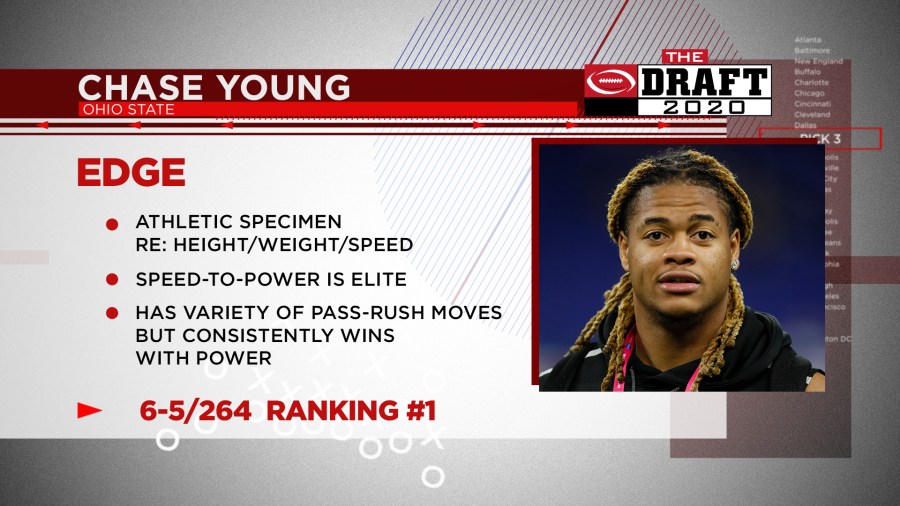
Round 1, Pick 1: Cincinnati – Joe Burrow, 6-3, 221 pounds, LSU
- Strengths: Accuracy, poise and athleticism, plus the ability to command an offense.
- Weaknesses: Doesn’t have the biggest arm.
- Fact: The Heisman Trophy winner almost doubled his 2018 passing yards per game (222.6) in 2019 (429.2).
No surprise atop this NFL draft as the Cincinnati Bengals have selected Joe Burrow, quarterback of national champion LSU, as the centerpiece of yet another rebuilding job.
Burrow, the third straight Heisman Trophy winner taken with the first overall selection, joins a team that went 2-14 in 2019 under first-year head coach Zac Taylor. The Bengals scored 279 points last season, third worst in the league, and also ranked 30th in total offense.
The previous time Cincinnati grabbed a Heisman quarterback to open the draft, it was Southern California’s Carson Palmer in 2003. Palmer led the Bengals to the playoffs twice.
In his spectacular season, Burrow threw for 60 — yes, 60 — touchdowns with only six interceptions. The Tigers beat six top 10 teams on their way to the national title.
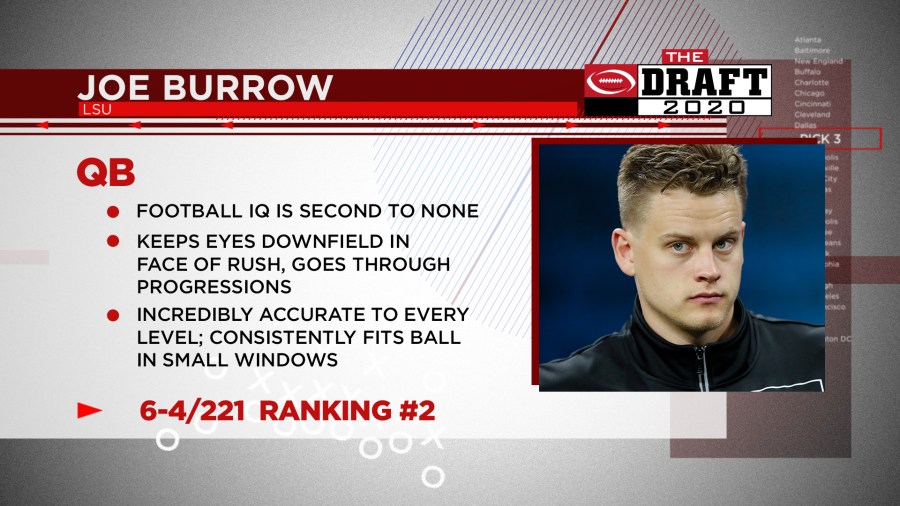
(The Associated Press contributed to this report)
